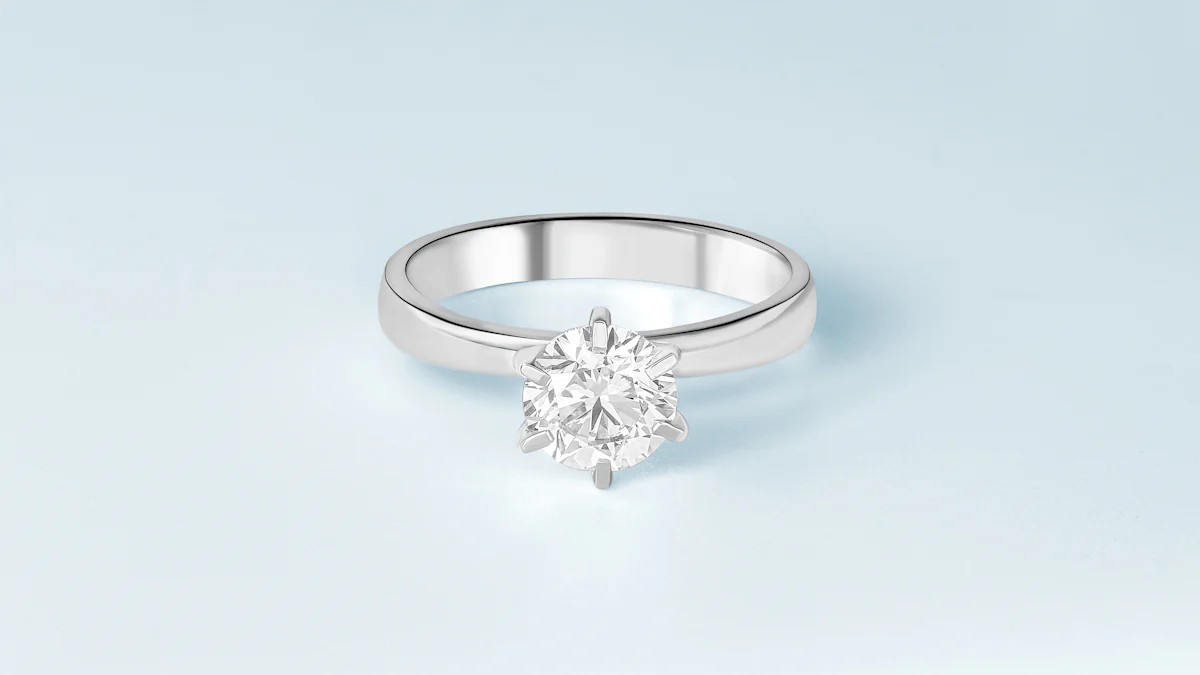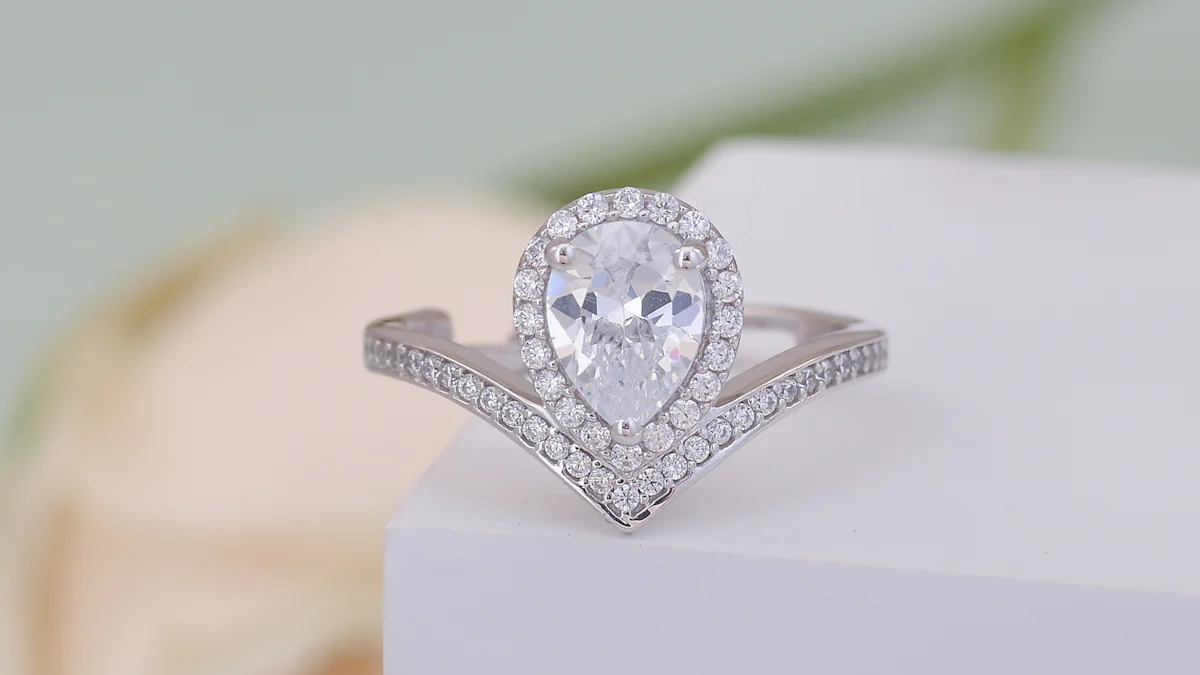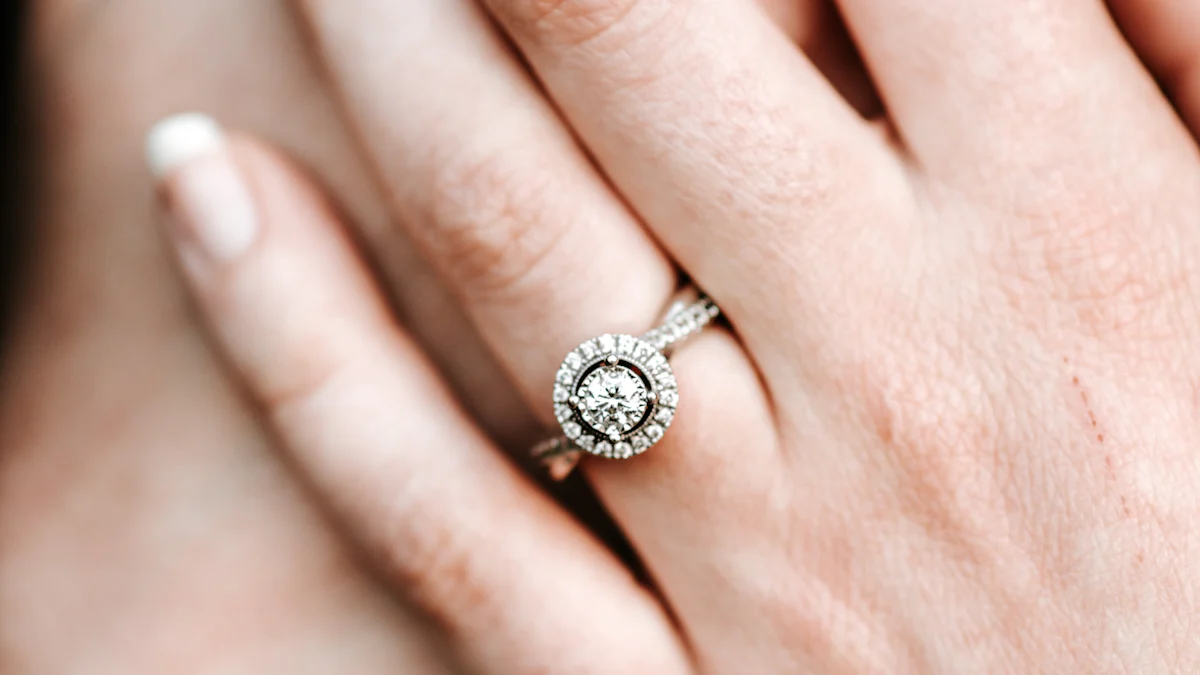Top Tips for Buying a 2.5 Carat Diamond Ring

When you're on the hunt for a 2.5 carat ring, you might wonder what tips can guide you to the perfect choice. Making informed decisions is crucial because this isn't just any purchase; it's an investment in a piece of jewelry that holds sentimental value. Most people, about 87%, prefer diamonds for engagement rings, highlighting their timeless appeal. However, it's not just about size. Many couples, around 41%, focus more on the cut and shape rather than the carat size. So, understanding these preferences can help you make a choice that truly resonates.
Key Takeaways
- Focus on the Four Cs—Cut, Clarity, Color, and Carat—to ensure you select a diamond that meets your quality and beauty expectations.
- Decide between luxury and non-luxury brands based on your budget and preferences; luxury brands offer prestige and quality, while non-luxury brands provide affordability and variety.
- Prioritize cut quality when choosing a diamond, as it significantly impacts the stone's brilliance and overall appearance.
- Stay informed about current market trends, such as popular styles and buyer preferences, to make a choice that aligns with both your taste and what’s in demand.
- Research and compare prices from different retailers to find the best value for your investment in a 2.5 carat ring.
- Protect your investment by insuring your ring; consider standalone jewelry insurance for comprehensive coverage against loss or damage.
- Regularly update your insurance policy and have your ring appraised to ensure coverage reflects its current market value.
Choosing Between Luxury and Non-Luxury Brands
When you're in the market for a 2.5 carat diamond ring, one of the first decisions you'll face is whether to go for a luxury brand or a non-luxury brand. Each option has its own set of advantages and disadvantages. Let's dive into what you can expect from both.
Pros and Cons of Luxury Brands
Luxury brands often come with a reputation for quality and prestige. Here's what you might consider:
-
Pros:
- High-Quality Materials: Luxury jewelry typically uses genuine silver, gold, platinum, and the finest diamonds. These materials ensure durability and a timeless look.
- Craftsmanship: You often get superior craftsmanship with luxury brands. The attention to detail can make a significant difference in the ring's overall appearance.
- Brand Prestige: Wearing a luxury brand can be a status symbol. It often comes with a sense of exclusivity and recognition.
-
Cons:
- Price: Luxury brands usually come with a hefty price tag. You pay a premium for the brand name and the quality materials.
- Limited Customization: Some luxury brands offer limited options for customization. You might find it challenging to get a unique design that fits your personal style.
Pros and Cons of Non-Luxury Brands
Non-luxury brands can be a great alternative if you're looking for something more budget-friendly. Here's what to keep in mind:
-
Pros:
- Affordability: Non-luxury brands often offer more affordable options. You can find beautiful rings without breaking the bank.
- Variety: These brands usually provide a wide range of styles and designs. You have more freedom to choose something that truly reflects your taste.
- Customization: Many non-luxury brands offer customization options. You can create a ring that feels personal and unique.
-
Cons:
- Material Quality: Non-luxury brands might use less expensive materials like brass, copper, or crystals. These materials may not have the same longevity or brilliance as precious metals and stones.
- Perceived Value: Some people might perceive non-luxury brands as less valuable. This perception can affect how the ring is viewed by others.
Choosing between luxury and non-luxury brands depends on your priorities and budget. Whether you value prestige and quality or affordability and variety, understanding these pros and cons will help you make an informed decision.
Understanding the Four Cs of a 2.5 Carat Ring

When you're buying a 2.5 carat ring, understanding the Four Cs—Cut, Clarity, Color, and Carat—is crucial. These factors determine the diamond's quality and value. Let's break them down so you can make an informed choice.
Cut
The cut of a diamond isn't just about its shape. It refers to how well the diamond's facets interact with light. A well-cut diamond will sparkle brilliantly, making it appear larger and more vibrant. When you're looking at a 2.5 carat ring, prioritize the cut. A superior cut can enhance the diamond's beauty and make it stand out. Remember, even if a diamond has a high carat weight, a poor cut can make it look dull.
Clarity
Clarity measures the presence of internal flaws, known as inclusions, and surface defects, called blemishes. Most diamonds have some imperfections, but many are invisible to the naked eye. For a 2.5 carat ring, you might want to aim for a clarity grade that balances quality and budget. A diamond with slight inclusions can still look flawless without the hefty price tag of a perfect stone.
Color
Diamonds come in various colors, but the most valuable ones are colorless. The color grading scale ranges from D (colorless) to Z (light yellow or brown). When choosing a 2.5 carat ring, consider how the diamond's color will complement the setting and the wearer's skin tone. A near-colorless diamond can offer great value while still appearing stunning.
Understanding these aspects of the Four Cs will help you select a 2.5 carat ring that meets your expectations in terms of beauty and value. Each C plays a role in the overall appeal of the diamond, so weigh them according to your priorities.
Carat
When you're considering a 2.5 carat ring, understanding the concept of carat weight is essential. Carat weight refers to the actual weight of the diamond, not its size. This distinction is crucial because two diamonds with the same carat weight can appear different in size due to their cut. Larger diamonds are rare, which makes them more valuable. As the carat weight increases, the price per carat also rises exponentially. This is why a 2.5 carat diamond can be significantly more expensive than a smaller diamond.
Here are some key points to keep in mind about carat weight:
-
Rarity and Value: Larger diamonds are less common, which adds to their allure and cost. A 2.5 carat diamond is often seen as a symbol of luxury and prestige.
-
Visual Impact: The carat weight affects how large the diamond appears. However, the cut quality can enhance or diminish this effect. A well-cut diamond will maximize its brilliance and make it look larger than its actual carat weight.
-
Price Considerations: The price of a diamond increases with its carat weight. When shopping for a 2.5 carat ring, it's important to balance carat weight with other factors like cut, color, and clarity to ensure you're getting the best value for your investment.
Understanding carat weight helps you make an informed decision when purchasing a diamond. By considering how carat weight interacts with other aspects of the diamond, you can choose a ring that meets your expectations in terms of both beauty and budget.
Market Trends and Preferences for a 2.5 Carat Ring
When you're considering a 2.5 carat ring, it's helpful to know what's trending in the market. This knowledge can guide you in choosing a ring that not only suits your taste but also aligns with current styles and preferences.
Popular Styles and Settings
In the world of diamond rings, styles and settings play a crucial role in the overall appeal of the piece. Here are some popular choices you might consider:
-
Solitaire Settings: This classic style remains a favorite for many. A solitaire setting allows the diamond to be the focal point, showcasing its brilliance and size. It's a timeless choice that never goes out of fashion.
-
Halo Settings: If you want to add extra sparkle, a halo setting might be the way to go. This style features a circle of smaller diamonds surrounding the center stone, enhancing its size and brilliance.
-
Vintage Styles: For those who appreciate a touch of nostalgia, vintage-inspired rings offer intricate designs and unique details. These rings often feature milgrain edges, filigree work, and colored gemstones.
-
Three-Stone Rings: Symbolizing the past, present, and future, three-stone rings are both meaningful and stylish. They provide an opportunity to mix different diamond shapes and sizes for a personalized look.
Choosing a style that resonates with you is important. Whether you prefer the simplicity of a solitaire or the glamour of a halo, there's a setting that will highlight the beauty of your 2.5 carat ring.
What Peers Are Buying
Understanding what others are choosing can offer valuable insights into current preferences. Many people today are leaning towards rings that balance size with quality. Here's what you might find interesting:
-
Focus on Quality: While carat weight is important, many buyers prioritize cut quality. A well-cut diamond maximizes sparkle and can make a diamond appear larger than its carat weight suggests.
-
Color and Clarity: Buyers often seek diamonds that offer a good balance between color and clarity. Near-colorless diamonds with slight inclusions can provide excellent value without compromising on appearance.
-
Certification: More consumers are ensuring their diamonds come with certification from reputable organizations like GIA or AGS. This guarantees the diamond's authenticity and quality.
By keeping an eye on these trends, you can make a choice that not only reflects your personal style but also aligns with what others are finding appealing in the market.
Pricing Strategies for a 2.5 Carat Ring
When you're shopping for a 2.5 carat ring, understanding pricing strategies can help you get the best value for your money. Let's explore how you can make a smart purchase.
How to Get the Best Value
-
Research and Compare: Start by researching different retailers. Compare prices for similar rings. This helps you understand the market and spot a good deal when you see one.
-
Prioritize Cut Quality: A well-cut diamond maximizes sparkle. It can make a diamond look larger than its carat weight suggests. Many buyers focus on cut quality over size. This choice often provides better value.
-
Consider Near-Colorless Diamonds: Diamonds in the G-H color range offer excellent value. They appear colorless to the naked eye but cost less than D-F color diamonds.
-
Look for Slight Inclusions: Opt for diamonds with slight inclusions that aren't visible without magnification. These diamonds are more affordable and still look stunning.
-
Negotiate: Don't hesitate to negotiate the price. Some jewelers are willing to offer discounts, especially if you're buying during a sale or purchasing multiple items.
Understanding Pricing Factors
Several factors influence the price of a 2.5 carat ring. Knowing these can help you make informed decisions:
-
Carat Weight: Larger diamonds are rarer and more expensive. The price per carat increases with size. However, two diamonds of the same carat weight can vary in price based on other factors.
-
Cut, Color, and Clarity: These three Cs significantly impact a diamond's price. A superior cut enhances brilliance, while higher color and clarity grades increase value.
-
Certification: Certified diamonds from reputable organizations like GIA or AGS often cost more. Certification ensures quality and authenticity, providing peace of mind.
-
Market Trends: Popular styles and cuts can affect pricing. For instance, the round brilliant cut remains the most popular, chosen by 41% of buyers. Oval shapes have also gained popularity, rising from 2% in 2015 to 19% in 2021. These trends can influence demand and price.
By understanding these pricing strategies and factors, you can confidently choose a 2.5 carat ring that fits your budget and preferences.
Importance of Insuring Your 2.5 Carat Ring

When you invest in a 2.5 carat ring, protecting it becomes essential. Insurance offers peace of mind by safeguarding your valuable purchase against unforeseen events. Let's explore the types of insurance coverage available and the steps to insure your ring.
Types of Insurance Coverage
-
Homeowner's or Renter's Insurance: Many people don't realize that their existing homeowner's or renter's insurance might cover jewelry. However, these policies often have limits on the amount they will pay for jewelry loss or theft. You might need to add a rider or endorsement to increase coverage for your 2.5 carat ring.
-
Standalone Jewelry Insurance: This type of insurance provides comprehensive coverage specifically for jewelry. It typically covers loss, theft, damage, and even mysterious disappearance. Standalone policies often offer higher coverage limits and more flexibility than standard homeowner's policies.
-
Appraisal-Based Coverage: Some insurers offer policies based on the appraised value of your ring. This ensures that you receive the full value of your ring if you need to make a claim. Regular appraisals are necessary to keep the coverage amount up to date with market changes.
Steps to Insure Your Purchase
-
Get an Appraisal: Start by having your 2.5 carat ring appraised by a certified gemologist. An appraisal provides a detailed description of the ring and its value, which is crucial for insurance purposes.
-
Research Insurance Providers: Look for insurance companies that specialize in jewelry coverage. Compare their policies, coverage limits, and premiums to find the best fit for your needs.
-
Review Policy Details: Before purchasing a policy, carefully review the terms and conditions. Ensure that it covers all potential risks, including loss, theft, and damage. Check if there are any exclusions or limitations.
-
Document Your Ring: Take clear photographs of your ring from multiple angles. Keep all purchase receipts, appraisal documents, and any other relevant paperwork in a safe place. This documentation will be invaluable if you need to file a claim.
-
Regularly Update Your Policy: As the value of diamonds can fluctuate, it's important to update your policy regularly. Have your ring reappraised every few years to ensure your coverage reflects its current market value.
By insuring your 2.5 carat ring, you protect your investment and ensure that you can enjoy its beauty without worry. Taking these steps will help you find the right coverage and keep your precious ring safe.
You've now got a solid foundation for buying a 2.5 carat ring. Remember, focus on the Four Cs—Cut, Clarity, Color, and Carat—to ensure you get the best quality. Weigh the pros and cons of luxury versus non-luxury brands to find what suits your style and budget. Stay informed about market trends and pricing strategies to make a savvy purchase. Don't forget to protect your investment with the right insurance. With these tips, you can confidently choose a ring that sparkles with beauty and value.
FAQ
What should I prioritize when buying a 2.5 carat diamond ring?
You should focus on the Four Cs: Cut, Clarity, Color, and Carat. These factors determine the diamond's quality and value. Prioritize cut quality because it affects the diamond's brilliance and appearance.
How can I ensure I'm buying a genuine diamond?
Always shop at reputable stores that come highly recommended. Educate yourself about diamonds before shopping. Ask for certification from organizations like GIA or AGS to verify the diamond's authenticity.
Is it better to buy a luxury brand or a non-luxury brand?
It depends on your priorities and budget. Luxury brands offer high-quality materials and craftsmanship but come with a higher price tag. Non-luxury brands provide affordability and variety, though they might use less expensive materials.
How do I choose the right setting for my 2.5 carat diamond ring?
Consider popular styles like solitaire, halo, vintage, or three-stone settings. Each style offers a unique look. Choose one that resonates with your taste and highlights the diamond's beauty.
What are the current market trends for diamond rings?
Solitaire and halo settings remain popular. Many buyers focus on cut quality over carat weight. Near-colorless diamonds with slight inclusions offer great value. Certification from reputable organizations is also a priority for many consumers.
How can I get the best value for my money?
Research and compare prices across different retailers. Prioritize cut quality and consider near-colorless diamonds. Look for slight inclusions that aren't visible to the naked eye. Don't hesitate to negotiate the price.
Why is insuring my 2.5 carat ring important?
Insurance protects your investment against loss, theft, or damage. It offers peace of mind, ensuring you can enjoy your ring without worry. Consider standalone jewelry insurance for comprehensive coverage.
What types of insurance coverage are available for my ring?
You can choose from homeowner's or renter's insurance, standalone jewelry insurance, or appraisal-based coverage. Each option offers different levels of protection. Review policy details to find the best fit for your needs.
How often should I update my ring's insurance policy?
Update your policy regularly, especially if the value of diamonds fluctuates. Have your ring reappraised every few years to ensure your coverage reflects its current market value.
What should I do if I'm unsure about my ring choice?
Take your time to browse different rings and settings. Find inspiration for the style you're looking for. Remember, finding the perfect ring is a balance between budget and style. Trust your instincts and choose a ring that symbolizes your love and commitment.
See Also
Your Ultimate Guide to Selecting a White Diamond Ring
Maximizing Profit: Tips for Selling Your Diamond Ring
A Comprehensive Guide to Choosing the Ideal Ruby Ring
Essential Elements That Influence Diamond Ring Prices
All-in-One Guide for Selecting Your Engagement and Wedding Ring

